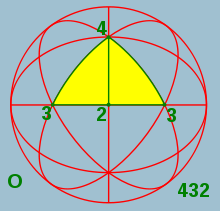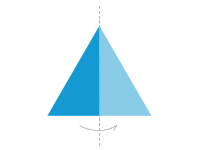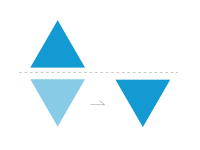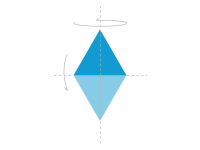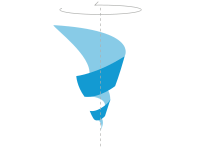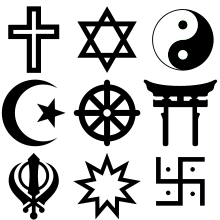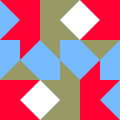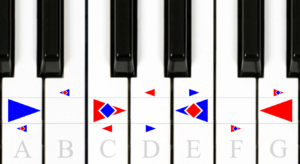- Symmetry
-
For other uses, see Symmetry (disambiguation).
 Leonardo da Vinci's Vitruvian Man (ca. 1487) is often used as a representation of symmetry in the human body and, by extension, the natural universe.
Leonardo da Vinci's Vitruvian Man (ca. 1487) is often used as a representation of symmetry in the human body and, by extension, the natural universe.
Symmetry (from Greek συμμετρεῖν symmetría "measure together") generally conveys two primary meanings. The first is an imprecise sense of harmonious or aesthetically pleasing proportionality and balance;[1][2] such that it reflects beauty or perfection. The second meaning is a precise and well-defined concept of balance or "patterned self-similarity" that can be demonstrated or proved according to the rules of a formal system: by geometry, through physics or otherwise.
Although the meanings are distinguishable in some contexts, both meanings of "symmetry" are related and discussed in parallel.[2][3]
The precise notions of symmetry have various measures and operational definitions. For example, symmetry may be observed
- with respect to the passage of time;
- as a spatial relationship;
- through geometric transformations such as scaling, reflection, and rotation;
- through other kinds of functional transformations;[4] and
- as an aspect of abstract objects, theoretic models, language, music and even knowledge itself.[5][6]
This article describes these notions of symmetry from four perspectives. The first is that of symmetry in geometry, which is the most familiar type of symmetry for many people. The second perspective is the more general meaning of symmetry in mathematics as a whole. The third perspective describes symmetry as it relates to science and technology. In this context, symmetries underlie some of the most profound results found in modern physics, including aspects of space and time. Finally, a fourth perspective discusses symmetry in the humanities, covering its rich and varied use in history, architecture, art, and religion.
The opposite of symmetry is asymmetry.
Contents
- 1 Symmetry in geometry
- 2 Symmetry in mathematics
- 3 Symmetry in science
- 4 Symmetry in history, religion, and culture
- 5 See also
- 6 References
- 7 External links
Symmetry in geometry
The most familiar type of symmetry for many people is geometrical symmetry. Formally, this means symmetry under a sub-group of the Euclidean group of isometries in two or three dimensional Euclidean space. These isometries consist of reflections, rotations, translations and combinations of these basic operations.
Reflection symmetry
Reflection symmetry, mirror symmetry, mirror-image symmetry, or bilateral symmetry is symmetry with respect to reflection.
In 1D, there is a point of symmetry. In 2D there is an axis of symmetry, in 3D a plane of symmetry. An object or figure which is indistinguishable from its transformed image is called mirror symmetric (see mirror image).
The axis of symmetry of a two-dimensional figure is a line such that, if a perpendicular is constructed, any two points lying on the perpendicular at equal distances from the axis of symmetry are identical. Another way to think about it is that if the shape were to be folded in half over the axis, the two halves would be identical: the two halves are each other's mirror image. Thus a square has four axes of symmetry, because there are four different ways to fold it and have the edges all match. A circle has infinitely many axes of symmetry, for the same reason.
If the letter T is reflected along a vertical axis, it appears the same. Note that this is sometimes called horizontal symmetry, and sometimes vertical symmetry. One can better use an unambiguous formulation, e.g. "T has a vertical symmetry axis" or "T has left-right symmetry."
The triangles with this symmetry are isosceles, the quadrilaterals with this symmetry are the kites and the isosceles trapezoids.
For each line or plane of reflection, the symmetry group is isomorphic with Cs (see point groups in three dimensions), one of the three types of order two (involutions), hence algebraically C2. The fundamental domain is a half-plane or half-space.
Bilateria (bilateral animals, including humans) are more or less symmetric with respect to the sagittal plane.
In certain contexts there is rotational symmetry anyway. Then mirror-image symmetry is equivalent with inversion symmetry; in such contexts in modern physics the term P-symmetry is used for both (P stands for parity).
For more general types of reflection there are corresponding more general types of reflection symmetry. Examples:
- with respect to a non-isometric affine involution (an oblique reflection in a line, plane, etc.).
- with respect to circle inversion
Rotational symmetry
Rotational symmetry is symmetry with respect to some or all rotations in m-dimensional Euclidean space. Rotations are direct isometries, i.e., isometries preserving orientation. Therefore a symmetry group of rotational symmetry is a subgroup of E+(m).
Symmetry with respect to all rotations about all points implies translational symmetry with respect to all translations, and the symmetry group is the whole E+(m). This does not apply for objects because it makes space homogeneous, but it may apply for physical laws.
For symmetry with respect to rotations about a point we can take that point as origin. These rotations form the special orthogonal group SO(m), the group of m×m orthogonal matrices with determinant 1. For m=3 this is the rotation group.
In another meaning of the word, the rotation group of an object is the symmetry group within E+(n), the group of direct isometries; in other words, the intersection of the full symmetry group and the group of direct isometries. For chiral objects it is the same as the full symmetry group.
Laws of physics are SO(3)-invariant if they do not distinguish different directions in space. Because of Noether's theorem, rotational symmetry of a physical system is equivalent to the angular momentum conservation law. See also rotational invariance.
Translational symmetry
Translational symmetry leaves an object invariant under a discrete or continuous group of translations Ta(p) = p + a.
Glide reflection symmetry
A glide reflection symmetry (in 3D: a glide plane symmetry) means that a reflection in a line or plane combined with a translation along the line / in the plane, results in the same object. It implies translational symmetry with twice the translation vector.
The symmetry group is isomorphic with Z.
Rotoreflection symmetry
In 3D, rotoreflection or improper rotation in the strict sense is rotation about an axis, combined with reflection in a plane perpendicular to that axis. As symmetry groups with regard to a roto-reflection we can distinguish:
- the angle has no common divisor with 360°, the symmetry group is not discrete
- 2n-fold rotoreflection (angle of 180°/n) with symmetry group S2n of order 2n (not to be confused with symmetric groups, for which the same notation is used; abstract group C2n); a special case is n = 1, inversion, because it does not depend on the axis and the plane, it is characterized by just the point of inversion.
- Cnh (angle of 360°/n); for odd n this is generated by a single symmetry, and the abstract group is C2n, for even n this is not a basic symmetry but a combination. See also point groups in three dimensions.
Helical symmetry
Helical symmetry is the kind of symmetry seen in such everyday objects as springs, Slinky toys, drill bits, and augers. It can be thought of as rotational symmetry along with translation along the axis of rotation, the screw axis. The concept of helical symmetry can be visualized as the tracing in three-dimensional space that results from rotating an object at an even angular speed while simultaneously moving at another even speed along its axis of rotation (translation). At any one point in time, these two motions combine to give a coiling angle that helps define the properties of the tracing. When the tracing object rotates quickly and translates slowly, the coiling angle will be close to 0°. Conversely, if the rotation is slow and the translation is speedy, the coiling angle will approach 90°.
Three main classes of helical symmetry can be distinguished based on the interplay of the angle of coiling and translation symmetries along the axis:
- Infinite helical symmetry. If there are no distinguishing features along the length of a helix or helix-like object, the object will have infinite symmetry much like that of a circle, but with the additional requirement of translation along the long axis of the object to return it to its original appearance. A helix-like object is one that has at every point the regular angle of coiling of a helix, but which can also have a cross section of indefinitely high complexity, provided only that precisely the same cross section exists (usually after a rotation) at every point along the length of the object. Simple examples include evenly coiled springs, slinkies, drill bits, and augers. Stated more precisely, an object has infinite helical symmetries if for any small rotation of the object around its central axis there exists a point nearby (the translation distance) on that axis at which the object will appear exactly as it did before. It is this infinite helical symmetry that gives rise to the curious illusion of movement along the length of an auger or screw bit that is being rotated. It also provides the mechanically useful ability of such devices to move materials along their length, provided that they are combined with a force such as gravity or friction that allows the materials to resist simply rotating along with the drill or auger.
- n-fold helical symmetry. If the requirement that every cross section of the helical object be identical is relaxed, additional lesser helical symmetries become possible. For example, the cross section of the helical object may change, but still repeats itself in a regular fashion along the axis of the helical object. Consequently, objects of this type will exhibit a symmetry after a rotation by some fixed angle θ and a translation by some fixed distance, but will not in general be invariant for any rotation angle. If the angle (rotation) at which the symmetry occurs divides evenly into a full circle (360°), the result is the helical equivalent of a regular polygon. This case is called n-fold helical symmetry, where n = 360°/θ, see e.g. double helix. This concept can be further generalized to include cases where mθ is a multiple of 360°—that is, the cycle does eventually repeat, but only after more than one full rotation of the helical object.
- Non-repeating helical symmetry. This is the case in which the angle of rotation θ required to observe the symmetry is irrational. The angle of rotation never repeats exactly no matter how many times the helix is rotated. Such symmetries are created by using a non-repeating point group in two dimensions. DNA is an example of this type of non-repeating helical symmetry.[citation needed]
Non-isometric symmetries
A wider definition of geometric symmetry allows operations from a larger group than the Euclidean group of isometries. Examples of larger geometric symmetry groups are:
- The group of similarity transformations, i.e. affine transformations represented by a matrix A that is a scalar times an orthogonal matrix. Thus dilations are added, self-similarity is considered a symmetry.
- The group of affine transformations represented by a matrix A with determinant 1 or −1, i.e. the transformations which preserve area; this adds e.g. oblique reflection symmetry.
- The group of all bijective affine transformations.
- The group of Möbius transformations which preserve cross-ratios.
In Felix Klein's Erlangen program, each possible group of symmetries defines a geometry in which objects that are related by a member of the symmetry group are considered to be equivalent. For example, the Euclidean group defines Euclidean geometry, whereas the group of Möbius transformations defines projective geometry.
Scale symmetry and fractals
Scale symmetry refers to the idea that if an object is expanded or reduced in size, the new object has the same properties as the original. Scale symmetry is notable for the fact that it does not exist for most physical systems, a point that was first discerned by Galileo. Simple examples of the lack of scale symmetry in the physical world include the difference in the strength and size of the legs of elephants versus mice, and the observation that if a candle made of soft wax was enlarged to the size of a tall tree, it would immediately collapse under its own weight.
A more subtle form of scale symmetry is demonstrated by fractals. As conceived by Benoît Mandelbrot, fractals are a mathematical concept in which the structure of a complex form looks similar or even exactly the same no matter what degree of magnification is used to examine it. A coast is an example of a naturally occurring fractal, since it retains roughly comparable and similar-appearing complexity at every level from the view of a satellite to a microscopic examination of how the water laps up against individual grains of sand. The branching of trees, which enables children to use small twigs as stand-ins for full trees in dioramas, is another example.
This similarity to naturally occurring phenomena provides fractals with an everyday familiarity not typically seen with mathematically generated functions. As a consequence, they can produce strikingly beautiful results such as the Mandelbrot set. Intriguingly, fractals have also found a place in CG, or computer-generated movie effects, where their ability to create very complex curves with fractal symmetries results in more realistic virtual worlds.
Symmetry in mathematics
In formal terms, we say that a mathematical object is symmetric with respect to a given mathematical operation, if, when applied to the object, this operation preserves some property of the object. The set of operations that preserve a given property of the object form a group. Two objects are symmetric to each other with respect to a given group of operations if one is obtained from the other by some of the operations (and vice versa).
Mathematical model for symmetry
The set of all symmetry operations considered, on all objects in a set X, can be modeled as a group action g : G × X → X, where the image of g in G and x in X is written as g·x. If, for some g, g·x = y then x and y are said to be symmetrical to each other. For each object x, operations g for which g·x = x form a group, the symmetry group of the object, a subgroup of G. If the symmetry group of x is the trivial group then x is said to be asymmetric, otherwise symmetric. A general example is that G is a group of bijections g: V → V acting on the set of functions x: V → W by (gx)(v) = x(g−1(v)) (or a restricted set of such functions that is closed under the group action). Thus a group of bijections of space induces a group action on "objects" in it. The symmetry group of x consists of all g for which x(v) = x(g(v)) for all v. G is the symmetry group of the space itself, and of any object that is uniform throughout space. Some subgroups of G may not be the symmetry group of any object. For example, if the group contains for every v and w in V a g such that g(v) = w, then only the symmetry groups of constant functions x contain that group. However, the symmetry group of constant functions is G itself.
In a modified version for vector fields, we have (gx)(v) = h(g, x(g−1(v))) where h rotates any vectors and pseudovectors in x, and inverts any vectors (but not pseudovectors) according to rotation and inversion in g, see symmetry in physics. The symmetry group of x consists of all g for which x(v) = h(g, x(g(v))) for all v. In this case the symmetry group of a constant function may be a proper subgroup of G: a constant vector has only rotational symmetry with respect to rotation about an axis if that axis is in the direction of the vector, and only inversion symmetry if it is zero.
For a common notion of symmetry in Euclidean space, G is the Euclidean group E(n), the group of isometries, and V is the Euclidean space. The rotation group of an object is the symmetry group if G is restricted to E+(n), the group of direct isometries. (For generalizations, see the next subsection.) Objects can be modeled as functions x, of which a value may represent a selection of properties such as color, density, chemical composition, etc. Depending on the selection we consider just symmetries of sets of points (x is just a Boolean function of position v), or, at the other extreme, e.g. symmetry of right and left hand with all their structure.
For a given symmetry group, the properties of part of the object, fully define the whole object. Considering points equivalent which, due to the symmetry, have the same properties, the equivalence classes are the orbits of the group action on the space itself. We need the value of x at one point in every orbit to define the full object. A set of such representatives forms a fundamental domain. The smallest fundamental domain does not have a symmetry; in this sense, one can say that symmetry relies upon asymmetry.
An object with a desired symmetry can be produced by choosing for every orbit a single function value. Starting from a given object x we can e.g.:
- take the values in a fundamental domain (i.e., add copies of the object)
- take for each orbit some kind of average or sum of the values of x at the points of the orbit (ditto, where the copies may overlap)
If it is desired to have no more symmetry than that in the symmetry group, then the object to be copied should be asymmetric.
As pointed out above, some groups of isometries are not the symmetry group of any object, except in the modified model for vector fields. For example, this applies in 1D for the group of all translations. The fundamental domain is only one point, so we can not make it asymmetric, so any "pattern" invariant under translation is also invariant under reflection (these are the uniform "patterns").
In the vector field version continuous translational symmetry does not imply reflectional symmetry: the function value is constant, but if it contains nonzero vectors, there is no reflectional symmetry. If there is also reflectional symmetry, the constant function value contains no nonzero vectors, but it may contain nonzero pseudovectors. A corresponding 3D example is an infinite cylinder with a current perpendicular to the axis; the magnetic field (a pseudovector) is, in the direction of the cylinder, constant, but nonzero. For vectors (in particular the current density) we have symmetry in every plane perpendicular to the cylinder, as well as cylindrical symmetry. This cylindrical symmetry without mirror planes through the axis is also only possible in the vector field version of the symmetry concept. A similar example is a cylinder rotating about its axis, where magnetic field and current density are replaced by angular momentum and velocity, respectively.
A symmetry group is said to act transitively on a repeated feature of an object if, for every pair of occurrences of the feature there is a symmetry operation mapping the first to the second. For example, in 1D, the symmetry group of {...,1,2,5,6,9,10,13,14,...} acts transitively on all these points, while {...,1,2,3,5,6,7,9,10,11,13,14,15,...} does not act transitively on all points. Equivalently, the first set is only one conjugacy class with respect to isometries, while the second has two classes.
Symmetric functions
A symmetric function is a function which is unchanged by any permutation of its variables. For example, x + y + z and xy + yz + xz are symmetric functions, whereas x2 – yz is not.
A function may be unchanged by a sub-group of all the permutations of its variables. For example, ac + 3ab + bc is unchanged if a and b are exchanged; its symmetry group is isomorphic to C2.
Symmetry in logic
A dyadic relation R is symmetric if and only if, whenever it's true that Rab, it's true that Rba. Thus, “is the same age as” is symmetrical, for if Paul is the same age as Mary, then Mary is the same age as Paul.
Symmetric binary logical connectives are "and" (∧,
 , or &), "or" (∨), "biconditional" (if and only if) (↔), NAND ("not-and"), XOR ("not-biconditional"), and NOR ("not-or").
, or &), "or" (∨), "biconditional" (if and only if) (↔), NAND ("not-and"), XOR ("not-biconditional"), and NOR ("not-or").Symmetry in science
Symmetry in physics
Symmetry in physics has been generalized to mean invariance—that is, lack of change—under any kind of transformation, for example arbitrary coordinate transformations. This concept has become one of the most powerful tools of theoretical physics, as it has become evident that practically all laws of nature originate in symmetries. In fact, this role inspired the Nobel laureate PW Anderson to write in his widely read 1972 article More is Different that "it is only slightly overstating the case to say that physics is the study of symmetry." See Noether's theorem (which, in greatly simplified form, states that for every continuous mathematical symmetry, there is a corresponding conserved quantity; a conserved current, in Noether's original language); and also, Wigner's classification, which says that the symmetries of the laws of physics determine the properties of the particles found in nature.
Symmetry in physical objects
Classical objects
Although an everyday object may appear exactly the same after a symmetry operation such as a rotation or an exchange of two identical parts has been performed on it, it is readily apparent that such a symmetry is true only as an approximation for any ordinary physical object.
For example, if one rotates a precisely machined aluminum equilateral triangle 120 degrees around its center, a casual observer brought in before and after the rotation will be unable to decide whether or not such a rotation took place. However, the reality is that each corner of a triangle will always appear unique when examined with sufficient precision. An observer armed with sufficiently detailed measuring equipment such as optical or electron microscopes will not be fooled; he will immediately recognize that the object has been rotated by looking for details such as crystals or minor deformities.
Such simple thought experiments show that assertions of symmetry in everyday physical objects are always a matter of approximate similarity rather than of precise mathematical sameness. The most important consequence of this approximate nature of symmetries in everyday physical objects is that such symmetries have minimal or no impacts on the physics of such objects. Consequently, only the deeper symmetries of space and time play a major role in classical physics—that is, the physics of large, everyday objects.
Quantum objects
Remarkably, there exists a realm of physics for which mathematical assertions of simple symmetries in real objects cease to be approximations. That is the domain of quantum physics, which for the most part is the physics of very small, very simple objects such as electrons, protons, light, and atoms.
Unlike everyday objects, objects such as electrons have very limited numbers of configurations, called states, in which they can exist. This means that when symmetry operations such as exchanging the positions of components are applied to them, the resulting new configurations often cannot be distinguished from the originals no matter how diligent an observer is. Consequently, for sufficiently small and simple objects the generic mathematical symmetry assertion F(x) = x ceases to be approximate, and instead becomes an experimentally precise and accurate description of the situation in the real world.
Consequences of quantum symmetry
While it makes sense that symmetries could become exact when applied to very simple objects, the immediate intuition is that such a detail should not affect the physics of such objects in any significant way. This is in part because it is very difficult to view the concept of exact similarity as physically meaningful. Our mental picture of such situations is invariably the same one we use for large objects: We picture objects or configurations that are very, very similar, but for which if we could "look closer" we would still be able to tell the difference.
However, the assumption that exact symmetries in very small objects should not make any difference in their physics was discovered in the early 1900s to be spectacularly incorrect. The situation was succinctly summarized by Richard Feynman in the direct transcripts of his Feynman Lectures on Physics, Volume III, Section 3.4, Identical particles. (Unfortunately, the quote was edited out of the printed version of the same lecture.)
- "... if there is a physical situation in which it is impossible to tell which way it happened, it always interferes; it never fails."
The word "interferes" in this context is a quick way of saying that such objects fall under the rules of quantum mechanics, in which they behave more like waves that interfere than like everyday large objects.
In short, when an object becomes so simple that a symmetry assertion of the form F(x) = x becomes an exact statement of experimentally verifiable sameness, x ceases to follow the rules of classical physics and must instead be modeled using the more complex—and often far less intuitive—rules of quantum physics.
This transition also provides an important insight into why the mathematics of symmetry are so deeply intertwined with those of quantum mechanics. When physical systems make the transition from symmetries that are approximate to ones that are exact, the mathematical expressions of those symmetries cease to be approximations and are transformed into precise definitions of the underlying nature of the objects. From that point on, the correlation of such objects to their mathematical descriptions becomes so close that it is difficult to separate the two.
Generalizations of symmetry
If we have a given set of objects with some structure, then it is possible for a symmetry to merely convert only one object into another, instead of acting upon all possible objects simultaneously. This requires a generalization from the concept of symmetry group to that of a groupoid. Indeed, A. Connes in his book `Non-commutative geometry' writes that Heisenberg discovered quantum mechanics by considering the groupoid of transitions of the hydrogen spectrum.
The notion of groupoid also leads to notions of multiple groupoids, namely sets with many compatible groupoid structures, a structure which trivialises to abelian groups if one restricts to groups. This leads to prospects of `higher order symmetry' which have been a little explored, as follows.
The automorphisms of a set, or a set with some structure, form a group, which models a homotopy 1-type. The automorphisms of a group G naturally form a crossed module
 , and crossed modules give an algebraic model of homotopy 2-types. At the next stage, automorphisms of a crossed module fit into a structure known as a crossed square, and this structure is known to give an algebraic model of homotopy 3-types. It is not known how this procedure of generalising symmetry may be continued, although crossed n-cubes have been defined and used in algebraic topology, and these structures are only slowly being brought into theoretical physics.[7][8]
, and crossed modules give an algebraic model of homotopy 2-types. At the next stage, automorphisms of a crossed module fit into a structure known as a crossed square, and this structure is known to give an algebraic model of homotopy 3-types. It is not known how this procedure of generalising symmetry may be continued, although crossed n-cubes have been defined and used in algebraic topology, and these structures are only slowly being brought into theoretical physics.[7][8]Physicists have come up with other directions of generalization, such as supersymmetry and quantum groups, yet the different options are indistinguishable during various circumstances.
Symmetry in biology
Symmetry in chemistry
Symmetry is important to chemistry because it explains observations in spectroscopy, quantum chemistry and crystallography. It draws heavily on group theory.
Symmetry in history, religion, and culture
In any human endeavor for which an impressive visual result is part of the desired objective, symmetries play a profound role. The innate appeal of symmetry can be found in our reactions to happening across highly symmetrical natural objects, such as precisely formed crystals or beautifully spiraled seashells. Our first reaction in finding such an object often is to wonder whether we have found an object created by a fellow human, followed quickly by surprise that the symmetries that caught our attention are derived from nature itself. In both reactions we give away our inclination to view symmetries both as beautiful and, in some fashion, informative of the world around us.[citation needed]
Symmetry in religious symbols
The tendency of people to see purpose in symmetry suggests at least one reason why symmetries are often an integral part of the symbols of world religions.[citation needed] Just a few of many examples include the sixfold rotational symmetry of Judaism's Star of David, the twofold point symmetry of Taoism's Taijitu or Yin-Yang, the bilateral symmetry of Christianity's cross and Sikhism's Khanda, or the fourfold point symmetry of Hindu's ancient version of the swastika. With its strong prohibitions against the use of representational images, Islam, and in particular the Sunni branch of Islam, has developed intricate use of symmetries.[citation needed]
Symmetry in social interactions
People observe the symmetrical nature, often including asymmetrical balance, of social interactions in a variety of contexts. These include assessments of reciprocity, empathy, apology, dialog, respect, justice, and revenge. Symmetrical interactions send the message "we are all the same" while asymmetrical interactions send the message "I am special; better than you." Peer relationships are based on symmetry, power relationships are based on asymmetry.[9]
Symmetry in architecture
Another human endeavor in which the visual result plays a vital part in the overall result is architecture. Both in ancient times, the ability of a large structure to impress or even intimidate its viewers has often been a major part of its purpose, and the use of symmetry is an inescapable aspect of how to accomplish such goals.
Just a few examples of ancient examples of architectures that made powerful use of symmetry to impress those around them included the Egyptian Pyramids, the Greek Parthenon, the first and second Temple of Jerusalem, China's Forbidden City, Cambodia's Angkor Wat complex, and the many temples and pyramids of ancient Pre-Columbian civilizations. More recent historical examples of architectures emphasizing symmetries include Gothic architecture cathedrals, and American President Thomas Jefferson's Monticello home. The Taj Mahal is also an example of symmetry.
An interesting example of a broken symmetry in architecture is the Leaning Tower of Pisa, whose notoriety stems in no small part not for the intended symmetry of its design, but for the violation of that symmetry from the lean that developed while it was still under construction. Modern examples of architectures that make impressive or complex use of various symmetries include Australia's Sydney Opera House and Houston, Texas's simpler Astrodome.
Symmetry finds its ways into architecture at every scale, from the overall external views, through the layout of the individual floor plans, and down to the design of individual building elements such as intricately caved doors, stained glass windows, tile mosaics, friezes, stairwells, stair rails, and balustradess. For sheer complexity and sophistication in the exploitation of symmetry as an architectural element, Islamic buildings such as the Taj Mahal often eclipse those of other cultures and ages, due in part to the general prohibition of Islam against using images of people or animals.[10][11]
Symmetry in pottery and metal vessels
Since the earliest uses of pottery wheels to help shape clay vessels, pottery has had a strong relationship to symmetry. As a minimum, pottery created using a wheel necessarily begins with full rotational symmetry in its cross-section, while allowing substantial freedom of shape in the vertical direction. Upon this inherently symmetrical starting point cultures from ancient times have tended to add further patterns that tend to exploit or in many cases reduce the original full rotational symmetry to a point where some specific visual objective is achieved. For example, Persian pottery dating from the fourth millennium B.C. and earlier used symmetric zigzags, squares, cross-hatchings, and repetitions of figures to produce more complex and visually striking overall designs.
Cast metal vessels lacked the inherent rotational symmetry of wheel-made pottery, but otherwise provided a similar opportunity to decorate their surfaces with patterns pleasing to those who used them. The ancient Chinese, for example, used symmetrical patterns in their bronze castings as early as the 17th century B.C. Bronze vessels exhibited both a bilateral main motif and a repetitive translated border design.[12][13][14]
Symmetry in quilts
As quilts are made from square blocks (usually 9, 16, or 25 pieces to a block) with each smaller piece usually consisting of fabric triangles, the craft lends itself readily to the application of symmetry.[15]
Symmetry in carpets and rugs
A long tradition of the use of symmetry in carpet and rug patterns spans a variety of cultures. American Navajo Indians used bold diagonals and rectangular motifs. Many Oriental rugs have intricate reflected centers and borders that translate a pattern. Not surprisingly, rectangular rugs typically use quadrilateral symmetry—that is, motifs that are reflected across both the horizontal and vertical axes.[16][17]
Symmetry in music
Symmetry is not restricted to the visual arts. Its role in the history of music touches many aspects of the creation and perception of music.
Musical form
Symmetry has been used as a formal constraint by many composers, such as the arch (swell) form (ABCBA) used by Steve Reich, Béla Bartók, and James Tenney. In classical music, Bach used the symmetry concepts of permutation and invariance.[18]
Pitch structures
Symmetry is also an important consideration in the formation of scales and chords, traditional or tonal music being made up of non-symmetrical groups of pitches, such as the diatonic scale or the major chord. Symmetrical scales or chords, such as the whole tone scale, augmented chord, or diminished seventh chord (diminished-diminished seventh), are said to lack direction or a sense of forward motion, are ambiguous as to the key or tonal center, and have a less specific diatonic functionality. However, composers such as Alban Berg, Béla Bartók, and George Perle have used axes of symmetry and/or interval cycles in an analogous way to keys or non-tonal tonal centers.
Perle (1992) explains "C–E, D–F#, [and] Eb–G, are different instances of the same interval...the other kind of identity. ..has to do with axes of symmetry. C–E belongs to a family of symmetrically related dyads as follows:"
D D# E F F# G G# D C# C B A# A G# Thus in addition to being part of the interval-4 family, C–E is also a part of the sum-4 family (with C equal to 0).
+ 2 3 4 5 6 7 8 2 1 0 11 10 9 8 4 4 4 4 4 4 4 Interval cycles are symmetrical and thus non-diatonic. However, a seven pitch segment of C5 (the cycle of fifths, which are enharmonic with the cycle of fourths) will produce the diatonic major scale. Cyclic tonal progressions in the works of Romantic composers such as Gustav Mahler and Richard Wagner form a link with the cyclic pitch successions in the atonal music of Modernists such as Bartók, Alexander Scriabin, Edgard Varèse, and the Vienna school. At the same time, these progressions signal the end of tonality.
The first extended composition consistently based on symmetrical pitch relations was probably Alban Berg's Quartet, Op. 3 (1910). (Perle, 1990)
Equivalency
Tone rows or pitch class sets which are invariant under retrograde are horizontally symmetrical, under inversion vertically. See also Asymmetric rhythm.
Symmetry in other arts and crafts
The concept of symmetry is applied to the design of objects of all shapes and sizes. Other examples include beadwork, furniture, sand paintings, knotwork, masks, musical instruments, and many other endeavors.
Symmetry in aesthetics
The relationship of symmetry to aesthetics is complex. Certain simple symmetries, and in particular bilateral symmetry, seem to be deeply ingrained in the inherent perception by humans of the likely health or fitness of other living creatures, as can be seen by the simple experiment of distorting one side of the image of an attractive face and asking viewers to rate the attractiveness of the resulting image. Consequently, such symmetries that mimic biology tend to have an innate appeal that in turn drives a powerful tendency to create artifacts with similar symmetry. One only needs to imagine the difficulty in trying to market a highly asymmetrical car or truck to general automotive buyers to understand the power of biologically inspired symmetries such as bilateral symmetry.
Another more subtle appeal of symmetry is that of simplicity, which in turn has an implication of safety, security, and familiarity[citation needed]. A highly symmetrical room, for example, is unavoidably also a room in which anything out of place or potentially threatening can be identified easily and quickly[citation needed]. For example, people who have grown up in houses full of exact right angles and precisely identical artifacts can find their first experience in staying in a room with no exact right angles and no exactly identical artifacts to be highly disquieting.[citation needed] Symmetry thus can be a source of comfort not only as an indicator of biological health, but also of a safe and well-understood living environment.
Opposed to this is the tendency for excessive symmetry to be perceived as boring or uninteresting. Humans in particular have a powerful desire to exploit new opportunities or explore new possibilities, and an excessive degree of symmetry can convey a lack of such opportunities.[citation needed] Most people display a preference for figures that have a certain degree of simplicity and symmetry, but enough complexity to make them interesting.[19]
Yet another possibility is that when symmetries become too complex or too challenging, the human mind has a tendency to "tune them out" and perceive them in yet another fashion: as noise that conveys no useful information.[citation needed]
Finally, perceptions and appreciation of symmetries are also dependent on cultural background. The far greater use of complex geometric symmetries in many Islamic cultures, for example, makes it more likely that people from such cultures will appreciate such art forms (or, conversely, to rebel against them).[citation needed]
As in many human endeavors, the result of the confluence of many such factors is that effective use of symmetry in art and architecture is complex, intuitive, and highly dependent on the skills of the individuals who must weave and combine such factors within their own creative work. Along with texture, color, proportion, and other factors, symmetry is a powerful ingredient in any such synthesis; one only need to examine the Taj Mahal to powerful role that symmetry plays in determining the aesthetic appeal of an object.
Modernist architecture rejects symmetry, stating only a bad architect relies on symmetry[citation needed]; instead of symmetrical layout of blocks, masses and structures, Modernist architecture relies on wings and balance of masses. This notion of getting rid of symmetry was first encountered in International style. Some people find asymmetrical layouts of buildings and structures revolutionizing; other find them restless, boring and unnatural.
A few examples of the more explicit use of symmetries in art can be found in the remarkable art of M. C. Escher, the creative design of the mathematical concept of a wallpaper group, and the many applications (both mathematical and real world) of tiling.
See also
Symmetry in statistics
- Skewness, asymmetry of a statistical distribution
Symmetry in games and puzzles
- Symmetric games
- Sudoku
Symmetry in literature
Moral symmetry
Other
- Asymmetric rhythm
- Asymmetry
- Burnside's lemma
- Chirality
- M. C. Escher
- Even and odd functions
- Fixed points of isometry groups in Euclidean space – center of symmetry
- Gödel, Escher, Bach
- Ignacio Matte Blanco
- Semimetric, which is sometimes translated as symmetric in Russian texts.
- Semiotics of the structure - symmetry as a main characteristic of structure
- Spacetime symmetries
- Spontaneous symmetry breaking
- Symmetric relation
- Symmetries of polyiamonds
- Symmetries of polyominoes
- Symmetry (biology)
- Symmetry group
- Time symmetry
- Wallpaper group
References
- ^ Penrose, Roger (2007). Fearful Symmetry. City: Princeton. ISBN 9780691134826.
- ^ a b For example, Aristotle ascribed spherical shape to the heavenly bodies, attributing this formally defined geometric measure of symmetry to the natural order and perfection of the cosmos.
- ^ Weyl 1982
- ^ For example, operations such as moving across a regularly patterned tile floor or rotating an eight-sided vase, or complex transformations of equations or in the way music is played.
- ^ See e.g., Mainzer, Klaus (2005). Symmetry And Complexity: The Spirit and Beauty of Nonlinear Science. World Scientific. ISBN 9812561927.
- ^ Symmetric objects can be material, such as a person, crystal, quilt, floor tiles, or molecule, or it can be an abstract structure such as a mathematical equation or a series of tones (music).
- ^ n-category cafe – discussion of n-groups
- ^ `Higher dimensional group theory'
- ^ Emotional Competency Entry describing Symmetry
- ^ Williams: Symmetry in Architecture
- ^ Aslaksen: Mathematics in Art and Architecture
- ^ Chinavoc: The Art of Chinese Bronzes
- ^ Grant: Iranian Pottery in the Oriental Institute
- ^ The Metropolitan Museum of Art – Islamic Art
- ^ Quate: Exploring Geometry Through Quilts
- ^ Mallet: Tribal Oriental Rugs
- ^ Dilucchio: Navajo Rugs
- ^ see ("Fugue No. 21," pdf or Shockwave)
- ^ Arnheim, Rudolf (1969). Visual Thinking. University of California Press.
External links
Categories:
Wikimedia Foundation. 2010.


